Thank you to the Whyte Museum of the Canadian Rockies for granting permission to the Park Warden Service Alumni to post this interview on our website
Park Warden Alumni Society of Alberta
Oral History Project Phase 7.
Interview with Byron and Stevie Irons by Rod Wallace.
Phase 7 Oral History Project
Kooteneay National Park – April 10th, 2016.
Interview conducted by Rod Wallace

Photo courtesy of Larry Halvorson.
Rod: We are doing an oral history here today as part of the annual hockey tournament in Invermere, B.C. We are going to talk about the careers of these folks in the Kootenay National Park area. We hope to get some background on the involvement with National Parks over the years.
Rod: I’d like to begin with a little bit about your backgrounds, where you folks came from originally before you get started with Kootenay Park. Then we can tell a few episodes of your career here in the park.
Stevie: Well, I was basically raised in a military family. In 1966 we were posted to Edmonton and I went to university there. The summer of 1967 was the first time I came to Radium. A friend of mine, her boyfriend’s father owned a restaurant in Radium so for the next 3 summers I worked there. I went to University. I married somebody who is from here. And then in 1970 I applied for a job in Kootenay National Park and I got a seasonal position in the Information Bureau. I worked June 8th, 1970 to November 30th, 2010 – 40 years.
Rod: That is amazing. So obviously you know the area and the park and gained a lot of experience over those years.
Stevie: I started in info (Information). I worked at the gate (Park entrance), I was Central Registry Clerk, Accounts Payable Clerk, Superintendent’s Secretary, and then for 23 years I was a Pay Clerk, and then I finished off in general Human Resources.
Rod: So you saw lots of changes in things with people and the park itself over that period.
Stevie: Oh yes, lots. I worked with some incredible superintendents and some not so incredible superintendents, some great Chief Park Wardens and just a lot of great experiences. And it doesn’t get any better than working in a national park.
Rod: We all value our time in parks. Lots of challenges but all kinds of great experiences.
Stevie: Yes.
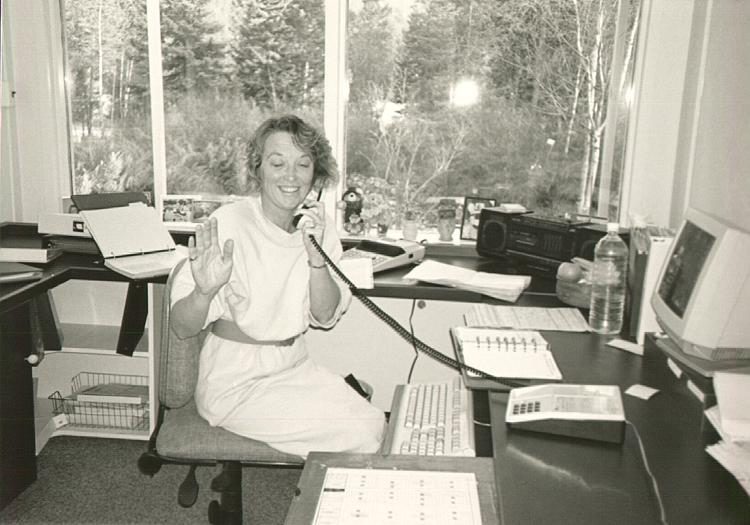
Stevie at work in the Kootenay Park Office. Photo compliments of Larry Halvorson.
Rod: Maybe you can kind of highlight some of the people that you worked with in the park.
Stevie: (I worked for) all the superintendents. And the best one I worked for was Mr. Gallagher. And those were the days when you called them “Mr.”. He was superintendent from 1974 to 1976 and I worked as his secretary. He was an amazing man. Just how he could manage people and how he treated people was very professional. He always came to work in a suit and a tie. Of course I was in my mid-twenties and I thought I knew everything. No I didn’t! And he taught me a lot. I remember one day … his office had this great view over the valley and my office was right next to his and he called me in one day and he pointed out the window where Bill Woods, who was a … labourer, was working down in the ditch cleaning it up. I remember him (Mr. Gallagher) saying to me, “You see Bill Woods out there?” That was another thing; Mr. Gallagher knew everybody’s name who worked in the park and everything about them. And he said to me, “See Bill Woods down there? Bill was a labourer who worked in the park. And I say “Yes”. And he says, “He’s just as important as the people who sit at that management table.” And that taught me a lot about how you treat people. Of all the superintendents I worked for, I never heard a negative word from staff about him. He was only with us two years and then they moved him to Revelstoke because there were issues in Revelstoke. And those were in the days when superintendents didn’t have any choice where they went. It was very much like the military. And at that time I think the Director General was Jack Nichol and he just said to Mr. Gallagher you are going to Revelstoke and he went.
Rod: The superintendents in those days seemed to have lots of power to be able to do what needed to be done locally.
Stevie: Exactly.
Rod: What about the relationship with people like that in the community?
Stevie: He was a big part of the community. He was a devout Roman Catholic so through the Church… he was a presence in our community even though he was only here for two years.
Rod. Well that is important. He recognized that the community…. got to be supportive and a lot of the people as you say in whatever capacity, come from the local area and need to be part of it.
Stevie: And the other thing, he was somebody that he played to the strength of his managers because he knew he couldn’t change their weaknesses. So that is another thing I learned from him. Another memorable character, other than my husband of course, was a man called Luigi Ambrosie and was our supervisor (and) just the greatest guy ever In 1955 he came from Italy to Canada and landed in Montreal. Then he got on a train and came across Canada. He stopped in Calgary and he gets out and it was during the (Calgary) Stampede so everyone is dressed up like cowboys and Indians and Luigi thought, “This is Canada?” Then he ultimately went on to Golden and then came south and got a job in the park. And that was in the days when bucket seats were bucket seats in the graders and the equipment. He started as an operator and later became supervisor. But he was another one who really knew how to manage his staff. And he never called them ‘my staff’- he didn’t use that term. And he just knew how to get the best of them.
Rod: That is good to hear.
Stevie: And then another character was Mr. Ian Jack. He was the Chief Park Naturalist.
Rod: I worked for him for two summers here, back in 1971 and 1972. I actually got offered a warden job the second year but I decided I’d better stay with Ian for another year because I learned an awful lot from him about the natural history and stuff. He was such a great person, both him and Larry Halvorson.
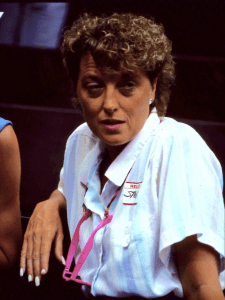
Photo courtesy of Larry Halvorson
Stevie: On my interview for the job in the Info Bureau there was Ian Jack, the Chief Park Naturalist, Sandy Robson, the Superintendent and John Watts, the General Works Manager. They did the interviews. I remember one of the questions was, Name a Lake in the park. And I am going, “You have lakes here?….I couldn’t believe that I actually got the job. I had started in the Info Bureau and the first time I saw my supervisor was a month later. He was very casual but we were friends right up until he passed away. And he really valued parks. He wasn’t an administrator. I can remember superintendents coming to me and saying “Please go downstairs and tell him he has to get this done.” And I’d go down there and say, “You have got to get this done.” And he’d eventually do it.
Rod: I remember when I first came out here from the city, and I met Ian Jack. I was just totally green and didn’t know one tree from another. I came out and Ian was very kind to me and we talked a little bit and he said, “Well let’s go do some glassing.” So I assumed we were going to do something with the binoculars and have a look at the bird life on the Columbia (River) – he meant’ the pub eh! (laughs) We went down to the pub and over a couple of beer I learned all kinds of things about Ian and what a great person he was. And everybody he knew in the whole area. Just a tremendous person, and it was so nice to see the community recognize his abilities and his contributions by the little plaque that is up t here on the highway. So sad that people like that seem to leave us earlier than they should.
Stevie: He was only 60 years old. He had only been retired for a few years.
Rod: Sad but true.
Stevie: You weren’t there when Kevin was there were you?
Rod: No. I was at the Crossing … with Greg Keesey.
Stevie: We swapped Greg Keesey and got Byron.
Rod: Oh, alright. We’ll get that story from Byron here later.
Stevie: Yes.
Rod: Interesting stuff. But I always valued that little bit of experience I had as a naturalist. I wasn’t a very good naturalist and I don’t even know why I got the job. It was kind of like yourself, I was always kind of interested in parks and went camping and whatnot, and that is why I applied for the job as a naturalist. I was working as a summer student in Calgary driving a garbage truck actually, when I got the call to work for parks. It was great.
Stevie: My first summer in 1970 I started in the Info Bureau and then half way through the summer Rusty ?- who worked at the gate – he got drunk one too many times and so he decided to quit. They needed somebody to go to the gate. The gate was managed not by the naturalists, but actually, by the accountant. And I remember Reg Cameron coming into us at the Info. Bureau and saying, “Who wants to go to the gate starting tomorrow? And I just said, “I guess I’ll go.” So I went to the gate which was another incredible experience because it was operated 24 hours a day. But their rules were that females could not work the graveyard shift which was great. We could work the afternoon shift. I remember working and Mike Hollinbow(?) would come to work at 10 minutes to 12 and he’d come in with his lunch box, his sleeping bag and I would go off shift at midnight and let’s say if I went through the gate again at a quarter after 12 (Midnight), Mike was already sleeping. (everybody laughs).
Rod: Interesting times.
Stevie: (to Byron) Rod was saying when he was in the park Greg Keesey was at Kootenay Crossing and I said, “Oh we swapped Greg Keesey and got you.”
Byron: Yes.
Rod: So tell us a little bit about your background Byron and how you got work for parks.
Byron: Well, I went to Forest Ranger School in 1967 in Ontario. I wanted to work for the Province of Ontario and I ended up doing that. I went up to Fort Frances and got my first permanent job and I could have been still with them. So I did that for a year. Then I decided to go back to school. I had a short-lived academic career at Lakehead University. But in the summer in between I went to work again for the Department of Lands and Forests. I wanted to be outside and wanted to take anything, so I would take any job. Tree planting came up and I thought, “Okay, sounds good.” So I went down there to Manitouwadge, Ontario. There was a guy that I went to school with in the Department of Lands and Forests who was working there. He was a Timber Supervisor. He said, “Byron, we need an extra guy on the Fire Program.” So I said, “Sure, I’m in!” So I worked on the Fire Crew from the summer of 1968 to the summer of 1971. It was a seasonal job but if things were going good I would work well into Christmas. I’d get a month or two off and then this one day I get a call on the phone. I was at the Ranger Station. They were asking for Byron Irons (and I wondered), “Who the hell is calling me here?” It turned out it was one of the ladies from our Rez down there – Curve Lake First Nation – she was working with Indian Affairs and she knew all about me. So, she said, “Byron, there’s a new national park being developed in your neck of the woods; Pukaskwa National Park (From Wikipedia, the free encyclopedia. Pukaskwa National Park is a national park located south of the town of Marathon, Ontario in the Thunder Bay District of northern Ontario, Canada. Established in 1978, Pukaskwa is known for its vistas of Lake Superior and boreal forests. The park covers an area of 1,878 square kilometres (725 sq mi), and protects part of the longest undeveloped shoreline anywhere on the Great Lakes.)

Photo courtesy of Larry Halvorson
She said, “Would you be interested in applying for a job there? And I knew about this park because it was within our ranger district. So I said “Sure.” She said, “We are having interviews in Marathon, Ontario on such and such a date.” So I went down there and I hadn’t seen her in a long time. Also, they had hired a Park Superintendent – Freddie Tremblay. So the interview came and went. They said, “You got the job.” So I left the Ontario Department of Lands and Forests on a Friday. On Monday morning I started with Parks Canada in Marathon. The parks office was a room in the Everest Hotel…. and the people called it the “Neverest Hotel” because it was right above the bar and it was quite the going concern in those days. Freddy Tremblay, he gave me some stuff… right away he said, “We’ve got to hire guys – patrolmen.” I was going to be the head patrolman. So, we’ve got to hire guys – okay. So my first week they gave me a briefcase, a rental car and I went around hiring guys from Pic Mobert… and Pitcairne (Ojibway rezes). Knowing the language and stuff we hired 6 guys. (Here I am) I got a briefcase, I got a car and I am going around hiring guys…I thought I was a wheel eh! (After we hired these guys), they said, “We are going to send all of you guys to Riding Mountain in Manitoba for 6 weeks (to train). So, we got a great big allowance, I think we got something like $1200 each for plane tickets to Winnipeg from Thunder Bay, for living expenses for the 6 weeks.

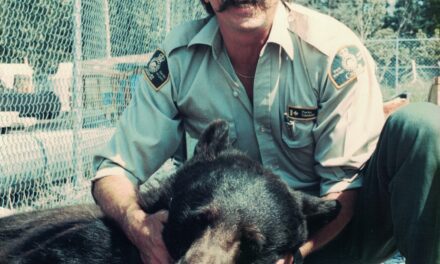
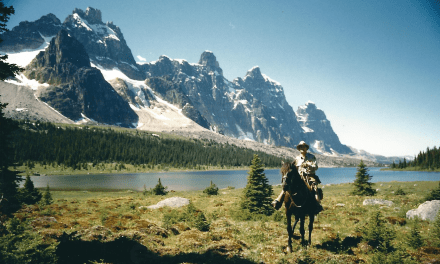
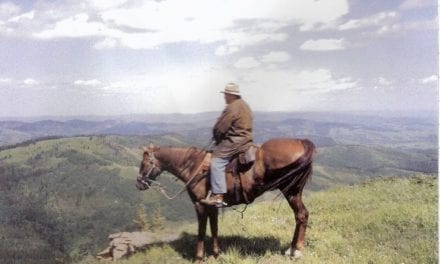
Recent Comments